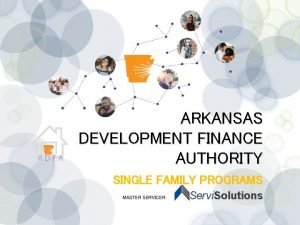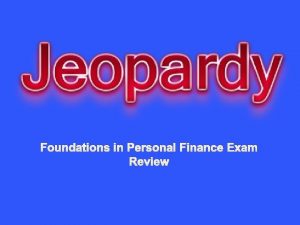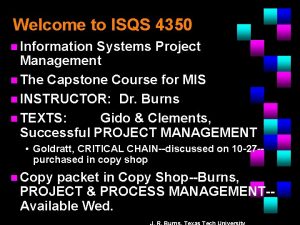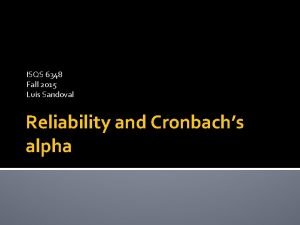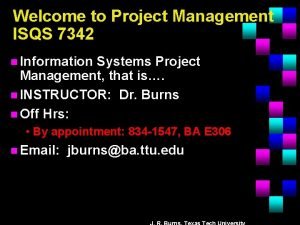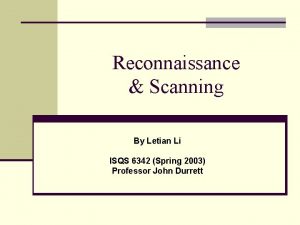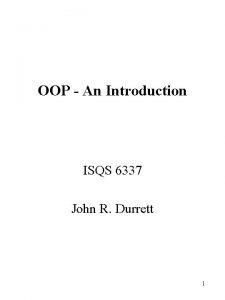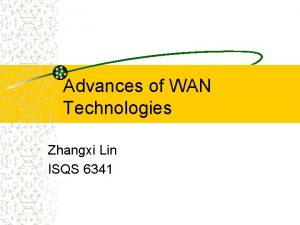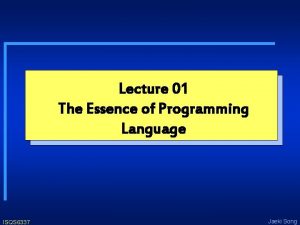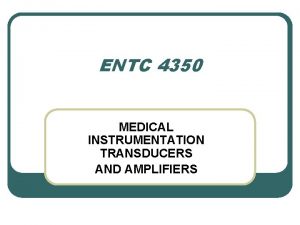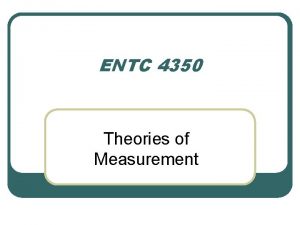Review for Final in ISQS 4350 Final will

















































































- Slides: 81

Review for Final in ISQS 4350 Final will take place: OO 1: Thursday, May 11, 2017, 7. 30 -10. 00 a. m. , this room 003: Monday, May 15, 2017, 7. 30 -10. 00 a. m. , this room 002: Tuesday, May 16, 2017, 1. 30 -4. 00 p. m. , this room

Format b Up to 100 multiple choice worth 60% b 3 discussion problems worth 40% b. Exam is closed notes/closed book b. Exam will be comprehensive • 60% of the exam will cover material since Exam 2

Bring b Pencils b Calculator b Orange Scantron sheet

Problem 12 -13

Conclusion to B: Problem 12 -13 b The project appears to be over budget but ahead of schedule based on the EVA analysis. When examining the Critical Path, we see the project is indeed ahead of schedule because critical task C is performing well in terms of cost and schedule. In this case the two criteria are consistent.

Problem 12 -19

Conclusion to B: Problem 12 -19 b From the EVA, the project appears to be behind schedule and over budget. When we examine the Critical Path, we see the project is indeed behind schedule because critical task C is behind schedule and over budget. In this case the two criteria (EVA and critical path) are consistent.

Possible Discussion Questions b Name five characteristics of a project b Successful project management entails what exactly b Name five phases of the project lifecycle • Show their sequence b Why is project management important b Name four core knowledge areas b Name five facilitating knowledge areas

More Discussion Questions b What is the tenth knowledge area and what is its purpose b Name some things we do poorly in projects b What term do we use to describe an event at which a major deliverable is completed? b What device or construct is often used to initiate a project? b What steps are used to launch critical chain project management?

More Discussion Questions b Name five or more ways to finish projects fast and frugal b Name three or more ways to motivate project players b Name some things you should not do to motivate project players b Draw Maslow’s needs hierarchy showing the names of all five levels b List Covey’s SEVEN habits

Typical Discussion Problems b Construct an activity on node network chart from a table; Determine duration, ES, EF, LS, LF and mark the critical path b Perform earned value analysis: BCWP, BCWS, ACWP, CV, SV, EV, PV, AC, CI, SI b Perform crashing of networks b What are the five phases that make up the CMMI? b Illustrate the tradeoff triangle b Assuming that half the durations are safety, redraw a project network showing all feeding and project buffers and their lengths

Multiple Choice b Chapters 9 -12 of Schwalbe • Not chapter 13 of Schwalbe • Look at the MC at the end of chs 9 -12 b Chapter 12 of Burns b Process maturity slides b Finishing projects fast slides b Critical chain concepts

Why has Project Management become so in-vogue? b Diversity of new products and product markets b Shorter life span of products b Rapid technological changes

Principles for Project Managers b The principle of Vision: In Proverbs— without vision, the people perish—I teach the importance of having a strong, compelling, galvanizing personal vision for projects, people b The principle of Work: People need work in order to be self-actualized, in order to have self-esteem—jobs and work have to be among our highest priorities as company, a community and country b The principle of Productivity: We want

More Principles b The principle of Trust: Stephen Covey tells us that to have trust, there has to be trustworthiness—and to have trustworthiness, there has to be competence and character b The principle of Love: Covey points out how important love is in leadership of projects. And along with love comes encouragement, forgiveness, faith, hope.

More Principles The principle of Empowerment: Empowerment means delegation with detachment. To do that you have to have alignment and trust. b The principle of Alignment: Your team has to have buy-in to the vision for the project —conformance to the vision—team members must align themselves with that vision b The principle of Focus: Once your task begins, drop everything and do nothing but b

Names five principles for project management b Vision b Learning b Work b Focus b Productivity b Maturity b Trust b Living for the good of others b Empowerment b Alignment

What are the major reasons for project failure? b Inadequate conceptualization and definition • Specifically, inadequate requirements b Absence of a plan b Unavailable resources when needed b Scope and hope creep b Unresponsive contractors who deliver their product late

The Project Management Life Cycle: PMBOK Progressive Elaboration

In which of the phases is a WBS started and completed? b Planning

In which of these phases is a project charter developed? b Initiating

In which of these phases are requirements determined? b Planning

What are the ten knowledge areas? b Scope management b Time management b Cost management b Quality management b. Integration management b Risk management b Procurement management b Human resource management b Communications management b Stakeholder management

In which phase is scope management most important? b The second phase: Planning

Competencies of the IT Project Manager b b b b Coach Mentor Leader Negotiator Assessor Encourager A positive ‘can do’ person Able to handle stress b b b b b Informer/communicator Motivator Delegator Visionary A good listener, after Covey An ability to develop people Interpersonal competencies Time management skills Builds trust and confidence 25

Capability Maturity Model b At which level is the extensive training and instruction performed? • Level 3 — normally called the defined level b At which level do we measure time (schedule) and cost? • Level 2 — Managed b At which level do we measure productivity and quality? • Level 4 — Quantitatively Managed

Five Levels

CMMI Staged Representation - 5 Maturity Levels Level 5 Optimizing Process performance continually improved through incremental and innovative technological improvements. Pr M oce at ur ss ity Level 4 Quantitatively Managed Level 3 Defined Level 2 Managed Level 1 Initial Processes are controlled using statistical and other quantitative techniques. Processes are well characterized and understood. Processes, standards, procedures, tools, etc. are defined at the organizational (Organization X ) level. Proactive. Processes are planned, documented, performed, monitored, and controlled at the project level. Often reactive. Processes are unpredictable, poorly controlled, reactive.

How long does it take to go from one level to the next? b One year, normally b As determined by an external appraiser

How does maturity help with estimation? b Estimates of cost and duration are determined in part by a history database

How does maturity help with quality issues (defects)? b A standardized, documented process is used b Defect (quality) databases and productivity databases are populated

How are processes improved, innovated with maturity concepts? b The fifth and final phase of any maturity model is OPTIMIZING in which Deming’s PDCA wheel is used in conjunction with Senge’s learning concepts Optimization!!

Product Life Cycles: PMBOK Products also have life cycles b The Systems Development Life Cycle (SDLC) is a framework for describing the phases involved in developing and maintaining information systems b Systems development projects can follow • Predictive life cycle: the scope of the project can be clearly articulated, is static and stable, and the schedule and cost can be predicted • Adaptive Software Development (ASD) life cycle: requirements cannot be clearly expressed, projects are mission driven and b

Predictive vs. Adaptive or Agile Predictive Adaptive High discipline b Less dependence on b High levels of discipline and documentation Unknown and b Project durations and b Iterative, time-boxed Static andarestable budgets more unstable development predictable requirements b Great for projects in b Users receive the which requirements are product incrementally, static and stable one piece at a time b Users first experience with the product is afterb User feedback is early it is entirely completed— and often b

Predictive Life Cycle Models Waterfall model: has well-defined, linear stages of systems development and support b Spiral model: shows that software is developed using an iterative or spiral approach rather than a linear approach b Incremental build model: provides for progressive development of operational software b Prototyping model: used for developing prototypes to clarify user requirements b Rapid Application Development (RAD) b

Waterfall and Spiral Life Cycle Models

Agile Software Development b Is an Adaptive Lifecycle approach b Is a time-boxed approach, usually b Agile software development has become popular to describe new approaches that focus on close collaboration between programming teams and business experts b Includes Scrum, Extreme programming and RUP

Agile Manifesto b We are uncovering better ways of developing software by doing it and helping others do it. Through this work we have come to value: b Individuals and interactions over processes and tools Working software over comprehensive documentation Customer collaboration over contract negotiation Responding to change over following a plan b b That is, while there is value in the items on the right, we value the items on the left more. 38

Scrum b According to the Scrum Alliance, Scrum is the leading agile development method for completing projects with a complex, innovative scope of work. b The term was coined in 1986 in a Harvard Business Review study that compared highperforming, cross-functional teams to the scrum formation used by rugby teams.

Scrum Framework

Activity Definition (Define Activities) is ___ b a subproject b a process b a problem b a plan b. WHICH? ? ?

Activity Definition (Define Activities) is part of what knowledge area? b Time management

Project Scope Management Processes b Plan Scope Management b Collect Requirements b Define Scope b Create WBS b Verify Scope b Control Scope

Project Time Management Processes b Plan Schedule Management b Define Activities b Sequence Activities b Estimate Activity Resources b Estimate Activity Durations b Develop Schedule b Control Schedule

Project Cost Management Processes b Plan Cost Management b Estimate Costs b Determine Budget b Control Costs

Project Quality Management Processes b Plan Quality Management b Perform Quality Assurance b Control Quality

Models are used in decision making… a) b) c) d) Never Sometimes Frequently Always, B/C a mental model is always used

The main purpose of a project plan is to ____ b acquire resources b guide project execution meet standards expectations b reduce risk b guide project execution

The most important output of project execution is b Not—change requests b Not—the WBS b Not—project plan b Not—requirements doc Work Products and The Final Project Deliverable

The Concept… b That work tends to fill up the time allotted for it is known as…. .

Most core knowledge areas have a b Planning process b And a b Controlling process

During the … b Planning phase, it is important that the project manager get Amongst the Stakeholders

Which of the following is NOT a way to motivate people? a) b) c) d) e) Compelling vision of where the project is going Treat people with respect, dignity Appreciate, value people by making them feel important, being interested in them Know what their “hot button” is All of the above are ways to motivate people

According to Goldratt… b Team players put too much ____ into their estimated durations

As Goldratt sees it, …. b The ultimate constraint in projects is….

Which of the following does Goldratt regard as a positive thing b Safety b Multitasking b Student syndrome b Win/lose contracting b None of the above

An activity has probabilistic completion times of 20, 50 and 80 for the optimistic, most likely and pessimistic durations. b What is the average time (duration) assuming a beta distribution? b 30 b 40 b 50 b 60 b 70

You should know b How to construct a NETWORK chart from a table b How to construct a Gantt chart from a table b How to perform NETWORK crashing b. How to do EVA

A work package… b Has $100, 000 budgeted for it b Is 50% complete b What is its BCWP (EV)? b $30, 000 b $40, 000 b $50, 000 b $60, 000

A task with a $10, 000 budget has a start date in the future b Its BCWS (PV) is • • $0 $5, 000 $10, 000 Can’t be determined

A task with a $10, 000 budget has a stop date in the past. b Its BCWS (PV) is b $0 b $5, 000 b $10, 000 b Can’t be determined

A task with a $10, 000 budget and a 6 day duration has just finished day 3 Ø Its BCWS is Ø $0 Ø $5, 000 Ø $10, 000 Ø Can’t be determined

A task has a budget of $20, 000 and a scheduled duration of 5 days b What is its daily burn rate? b If the project is 20% complete what is its BCWP? b If day three has just transpired, what is the BCWS? b What is the task’s SV (schedule variance) b Is the task ahead or behind schedule?

Questions about MS Project b Which key for subordination b Which key for linking b How to see total project duration and cost on the entry table b How to view project duration and cost on the project information dialog box b How to see all of the activity costs

For MS Project to cost your project, it needs to know b Resource hourly costs b Activity fixed costs b THIS IS ALL

In MS Project, durations/costs of phases (summary tasks) …. . b Containing one or more subordinate tasks can be specified only by MS Project

Task info is entered in which view of MS Project, usually? b The Gantt view, using the entry table

When using the standard calendar, MS Project assumes a. b. c. d. e. 8 -hour work days No work on Sat or Sun Two persons can do the work in half o f the time it takes one person All of the above Just a and b only

Questions over CRITICAL CHAIN b Major conclusions, recommendations b Goldratt’s view of EVA b What to Measure b What to Focus on

More Questions on CRITICAL CHAIN b To avoid non critical paths from becoming critical you should… b Critical chain is the sequence of tasks performed by key persons both on and off the critical path

Measurements should b Induce the parts to always do what is good for the system as a whole

Why does Goldratt not like BCWP, BCWS, ACWP? b Because they have no sensitivity to the critical path b Or any path for that matter…

If you are required to do a task on the critical path and …. b Your time to complete that task has arrived, then Goldratt recommends: bthat you drop everything and just focus (150%) on that task until you get it done!! • No multitasking • No procrastination (student syndrome)

Notes on shortening project durations b This should be done in the Planning and Budgeting stage b Crashing • Reducing the duration of tasks on the critical path b Fast-tracking • Starting tasks sooner b Adding resources? ? b Checking for parallelism opportunities in the schedule • Pull as much work off of the critical path as you can

More Tips on shortening project durations b REUSE, REUSE b Do it right the first time b Avoid changes to requirements

More techniques for shortening projects b Scrub the requirements • Remove from the requirements those items that add little or no value, but nevertheless are significant contributors to cost • Remember the Pareto principle— 80% of the value comes from 20% of the functionality b Do everything right the first time (AGAIN) b. REMOVE SAFETY--GOLDRATT

Network diagrams, drawn by commercial software b. Do they use • Activity-on-Node, or • Activity-on-Arrow representations?

Ending inspiration: Work for it!!

Don’t ever GIVE UP!!!

Final Slide: This means…. b Never stop learning • Become a life-long learner b Never stop maturing • And taking others to higher levels of maturity b Never stop loving • Love your work, your project peers, etc.

That’s it!! That’s all folks!! I enjoyed having you as a class—one of the best classes I’ve had.
 8663392432
8663392432 Uncontrollable spending ap gov
Uncontrollable spending ap gov Luftstrupen för medicinare
Luftstrupen för medicinare Varför kallas perioden 1918-1939 för mellankrigstiden
Varför kallas perioden 1918-1939 för mellankrigstiden Karttecken stig
Karttecken stig Arkimedes princip formel
Arkimedes princip formel Större än
Större än Elektronik för barn
Elektronik för barn Borra hål för knoppar
Borra hål för knoppar Smärtskolan kunskap för livet
Smärtskolan kunskap för livet Bris för vuxna
Bris för vuxna Mat för unga idrottare
Mat för unga idrottare Sura för anatom
Sura för anatom Trög för kemist
Trög för kemist Argument för teckenspråk som minoritetsspråk
Argument för teckenspråk som minoritetsspråk Typiska drag för en novell
Typiska drag för en novell Delegerande ledarstil
Delegerande ledarstil Ellika andolf
Ellika andolf Rita perspektiv
Rita perspektiv Blomman för dagen drog
Blomman för dagen drog Debatt mall
Debatt mall Redogör för vad psykologi är
Redogör för vad psykologi är Claes martinsson
Claes martinsson En lathund för arbete med kontinuitetshantering
En lathund för arbete med kontinuitetshantering Lek med former i förskolan
Lek med former i förskolan Publik sektor
Publik sektor Cirkelkomposition dikt
Cirkelkomposition dikt Etik och ledarskap etisk kod för chefer
Etik och ledarskap etisk kod för chefer Klädsel i rom
Klädsel i rom Vilken grundregel finns det för tronföljden i sverige?
Vilken grundregel finns det för tronföljden i sverige? Förklara densitet för barn
Förklara densitet för barn Ministerstyre för och nackdelar
Ministerstyre för och nackdelar Bamse för de yngsta
Bamse för de yngsta Tack för att ni lyssnade bild
Tack för att ni lyssnade bild Tillitsbaserad ledning
Tillitsbaserad ledning Plats för toran ark
Plats för toran ark Romarriket tidslinje
Romarriket tidslinje Nyckelkompetenser för livslångt lärande
Nyckelkompetenser för livslångt lärande Gibbs reflekterande cykel
Gibbs reflekterande cykel Verksamhetsanalys exempel
Verksamhetsanalys exempel Borstål, egenskaper
Borstål, egenskaper Shaktismen
Shaktismen Centrum för kunskap och säkerhet
Centrum för kunskap och säkerhet Adressändring ideell förening
Adressändring ideell förening Verktyg för automatisering av utbetalningar
Verktyg för automatisering av utbetalningar Hur stor skarns är det för ett barn att få cancer
Hur stor skarns är det för ett barn att få cancer Lyckans minut erik lindorm analys
Lyckans minut erik lindorm analys Inköpsprocessen steg för steg
Inköpsprocessen steg för steg Strategi för svensk viltförvaltning
Strategi för svensk viltförvaltning Beräkna standardavvikelse
Beräkna standardavvikelse Datorkunskap för nybörjare
Datorkunskap för nybörjare Tack för att ni har lyssnat
Tack för att ni har lyssnat Returpilarna
Returpilarna Läkarutlåtande för livränta
Läkarutlåtande för livränta Klassificeringsstruktur för kommunala verksamheter
Klassificeringsstruktur för kommunala verksamheter Tack för att ni lyssnade
Tack för att ni lyssnade Påbyggnader för flakfordon
Påbyggnader för flakfordon Egg för emanuel
Egg för emanuel Tack för att ni har lyssnat
Tack för att ni har lyssnat Mitos steg
Mitos steg Programskede byggprocessen
Programskede byggprocessen Personlig tidbok
Personlig tidbok Rutin för avvikelsehantering
Rutin för avvikelsehantering Myndigheten för delaktighet
Myndigheten för delaktighet Presentera för publik crossboss
Presentera för publik crossboss Rbk mätning
Rbk mätning Kontinuitetshantering
Kontinuitetshantering Kung som dog 1611
Kung som dog 1611 Tack för att ni har lyssnat
Tack för att ni har lyssnat Tobinskatten för och nackdelar
Tobinskatten för och nackdelar Boverket ka
Boverket ka Mall för referat
Mall för referat Earth science final exam
Earth science final exam Statics final exam review
Statics final exam review English 3 semester exam
English 3 semester exam Principles of business final exam answer key
Principles of business final exam answer key Personal finance final exam review
Personal finance final exam review Zoology semester 1 exam review answers
Zoology semester 1 exam review answers U.s. history semester 2 final exam
U.s. history semester 2 final exam Ied final exam
Ied final exam Spanish 1 review packet
Spanish 1 review packet Apes semester 1 final review
Apes semester 1 final review
